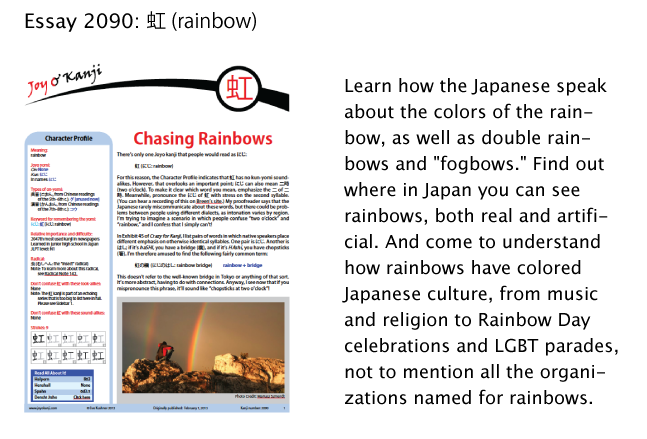Going in Circles
Let's start with a quiz! What do you think the following word could mean?
血迷う (ちまよう) blood + to lose
a. to lose dangerous amounts of blood
b. to menstruate
c. to give blood
d. to lose one's mind

Photo Credit: Eve Kushner
Here's the answer:
d. 血迷う (ちまよう: blood + to lose) means "to lose one's mind." According to my proofreader, we can understand each part of this word as follows:
血: with blood rushing to one's head
迷う: to lose self-control; lose one's normal judgment
Now for a new quiz. Consider the following word:
色香 (いろか: color and scent; loveliness; charm; sexy, sex appeal, attraction, erotic, coquettish, bewitching) color + scent
What could it mean when combined with 血迷う in this phrase?
色香に血迷う (いろかにちまよう)
color and scent; loveliness; charm (1st 2 kanji) + to lose one's mind (last 2 kanji)
a. to fade
b. to be infatuated
c. to become delirious; hallucinate
d. to become drunk

Photo Credit: Eve Kushner
This time the answer is b. That is:
色香に血迷う (いろかにちまよう: charm (1st 2 kanji) + to lose one's mind (last 2 kanji)) means "to be infatuated."
You could also drain the blood from this expression, producing a more common version of the phrase:
色香に迷う (いろかにまよう: to be infatuated)
charm (1st 2 kanji) + to lose control of oneself
A sample sentence should make matters clearer:
彼女の色香に迷った。
He was fascinated by her beauty.
彼女 (かのじょ: she)

Photo Credit: Eve Kushner
Now that you've found your way out of that confusion, you may be lost about another matter. What do the preceding photos represent?!
Allow me to explain. On the island of Shodoshima in the Inland Sea, a small neighborhood was intentionally laid out as a maze some three hundred years ago! The idea was to protect the village from any pirates who might invade.
Here's the Japanese word for "maze":
迷路 (めいろ: maze) to get lost + path, route
What a great breakdown! A maze is a series of paths that get you lost.
Logically enough, the area is called 迷路のまち. That appears on all the signs above. Note that まち (town) is always in hiragana, for some reason. (The second sign also has a picture of olives. Shodoshima has a huge olive industry!)
As for the pinhead of a mascot in the third sign, he stands at strategic intersections in the neighborhood, indicating to residents how to make it through the maze. These mascots are the equivalent of breadcrumbs, I suppose. The code is discreet enough that pirates would have remained in the dark. By the way, I'm telling you this because I'm trusting that you're not a pirate.

Photo Credit: Eve Kushner

Photo Credit: Eve Kushner
In the last photo, I imagine that you can read the green line easily enough, but the blue line is more confusing. Here's the first bit:
土高 (どこう), an abbreviation for 土庄高等学校 (とのしょうこうとうがっこう), which breaks down as follows:
土庄 (とのしょう: the town in which 迷路のまち is located)
高等学校 (こうとうがっこう: senior high school)
Oh—土高 is simply Tonosho High School! That's not so complicated!
Here's the rest of the line:
定時制 (ていじせい), an abbreviation for 定時制高等学校 (part-time high school)
That is, Tonosho High School is a high school for those who work in the daytime and take evening classes.
I have no idea about the link between the school and the signs; perhaps the students made them. But I will note one connection that jumps out at me.
Maze Town (迷路のまち) is located in 香川 (かがわ) Prefecture. These place names contain 迷 and 香, reminding me of phrases we've seen:
色香に血迷う (いろかにちまよう: to be infatuated)
色香に迷う (いろかにまよう: to be infatuated)
We're going in circles, as if we're lost in a maze!
Speaking of looping back on oneself, some of this material relates to essay 1255 on 香 (fragrance, sweet smell; incense; perfume), which came out last week! So let's get current. I've just published essay 2090 on 虹 (rainbow). Here's a preview:

Have a great weekend!

Comments